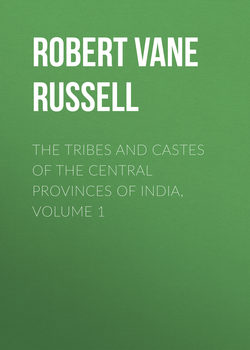Читать книгу The Tribes and Castes of the Central Provinces of India, Volume 1 - Robert Vane Russell - Страница 20
Part I.
Introductory Essay on Caste
Introductory Essay on Caste
17. The mixed castes. The village menials
ОглавлениеBut though among the four classical castes it was possible for the descendants of mixed unions between fathers of higher and mothers of lower caste to be admitted into their father’s caste, this would not have been the general rule. Such connections were very frequent and the Hindu classics account through them for the multiplication of castes. Long lists are given of new castes formed by the children of mixed marriages. The details of these genealogies seem to be destitute of any probability, and perhaps, therefore, instances of them are unnecessary. Matches between a man of higher and a woman of lower caste were called anuloma, or ‘with the hair’ or ‘grain,’ and were regarded as suitable and becoming. Those between a man of lower and a woman of higher caste were, on the other hand, known as pratiloma or ‘against the hair,’ and were considered as disgraceful and almost incestuous. The offspring of such unions are held to have constituted the lowest and most impure castes of scavengers, dog-eaters and so on. This doctrine is to be accounted for by the necessity of safeguarding the morality of women in a state of society where kinship is reckoned solely by male descent. The blood of the tribe and clan, and hence the right to membership and participation in the communal sacrifices, is then communicated to the child through the father; hence if the women are unchaste, children may be born into the family who have no such rights, and the whole basis of society is destroyed. For the same reason, since the tribal blood and life is communicated through males, the birth and standing of the mother are of little importance, and children are, as has been seen, easily admitted to their father’s rank. But already in Manu’s time the later and present view that both the father and mother must be of full status in the clan, tribe or caste in order to produce a legitimate child, has begun to prevail, and the children of all mixed marriages are relegated to a lower group. The offspring of these mixed unions did probably give rise to a class of different status in the village community. The lower-caste mother would usually have been taken into the father’s house and her children would be brought up in it. Thus they would eat the food of the household, even if they did not participate in the sacrificial feasts; and a class of this kind would be very useful for the performance of menial duties in and about the household, such as personal service, bringing water, and so on, for which the Sūdras, owing to their impurity, would be unsuitable. In the above manner a new grade of village menial might have arisen and have gradually been extended to the other village industries, so that a third group would be formed in the village community ranking between the cultivators and labourers. This gradation of the village community may perhaps still be discerned in the main social distinctions of the different Hindu castes at present. And an attempt will now be made to demonstrate this hypothesis in connection with a brief survey of the castes of the Province.
